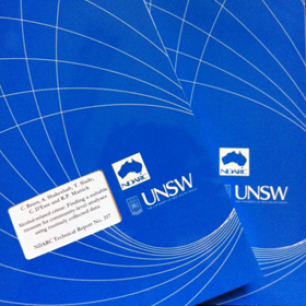NDARC Technical Report No. 207 (2004)
EXECUTIVE SUMMARY
Background
Almost one in ten Australians have tried ‘amphetamines’ in their life time, making amphetamines the second most commonly used illicit drug in Australia after cannabis (AIHW, 2002a). In the year 2000-01 the Australian Minimum Data Set for Alcohol and Other Drug Treatment Services (MDS-AODTS) recorded 6,979 treatment episodes where amphetamines were the primary drug of concern (AIHW, 2002b). This makes amphetamines the fourth most common drug for which people receive treatment after opioids, alcohol and cannabis, accounting for 9% of all episodes recorded through the Australian MDS-AODTS. More important, amphetamines were by far the major psychostimulant drug for which people received treatment, accounting for 96% of treatment episodes where psychostimulants were the main drug of concern (Jenner & McKetin, 2004). Despite the number of people receiving treatment for the use of amphetamines in Australia, there is only limited information available on the characteristics of those who receive treatment or the type of treatment services provided to this population. Most currently available information on amphetamine treatment in Australia is based on out-of-treatment samples of drug users from metropolitan regions (Hando & Hall, 1994; Hando, Topp & Hall, 1997; John, Kwiatkowski & Booth, 2001; Klee & Morris, 1994; Wright, Klee & Reid, 1999; Vincent, Shoobridge, Ask, Allsop & Ali, 1999; Baker, Boggs & Lewin, 2001a).
The purpose of the current study was to provide current information on the nature of treatment demand for amphetamine use in NSW, Australia. Data on drug treatment collected through the NSW MDS-AODTS was used to characterize clients for whom amphetamines were the primary drug of concern, to identify the types of treatment services they received, and to examine geographic trends in the level of treatment demand for amphetamines within NSW.
Method
Data on closed drug treatment episodes where ‘amphetamines’ were the client’s principal drug of concern were extracted from the NSW MDS-AODTS for the 2002-03 financial year. Characteristics of treatment (i.e., type of service provided, reason for ceasing treatment and duration of treatment) were calculated based on treatment episodes (N = 4,337) whereas client characteristics (i.e., demographics and drugs of concern) and the rates of treatment presentation by geographic region were calculated from data on unique clients presenting within individual treatment agencies rather than treatment episodes (N = 3,696). Definitions of all client, drug and treatment data items were those used by the NSW MDS-AODTS (New South Wales Department of Health, 2002). Geographic divisions used were metropolitan (Central Sydney, Northern Sydney, Western Sydney, and South Eastern Sydney Area Health Services), regional (Hunter, Illawarra, Central Coast, South Western Sydney and Wentworth Area Health Services) and rural (Far West, Greater Murray, Macquarie, Mid North Coast, Mid Western, New England, Northern Rivers and Southern Area Health Services). All statistical analyses were conducted using Intercooled STATA Version 8.
Findings
The majority of treatment presentations for amphetamines (72%) occurred outside the Sydney metropolitan region. Treatment presentations for the use of amphetamines were highest in the regional area of NSW bounding Sydney. This was true both in terms of the absolute number of treatment presentations and when calculated as a population rate. This geographic area accounted for 49% of all treatment presentations for the use of amphetamines in NSW.
The majority of clients receiving treatment for the use of amphetamines were English speaking, Australian born, injecting drug users of low socio-demographic standing. They had extremely low levels of employment (14%) and a high reliance on government benefits including pensions. Treatment clients were unlikely to live in a privately owned home, with the majority living in rental accommodation (55%). Over one in ten lived in temporary accommodation (e.g., shelters or refuges) or were homeless.
Counselling was the most common service provided to people receiving treatment for the use of amphetamines (35% of episodes), followed by residential rehabilitation (14%) and in-patient detoxification (13%). Less than half of all treatment episodes were completed (44%) and one third of the treatment episodes were terminated for reasons related to non-compliance. Non-compliance was particularly high for residential rehabilitation. Poor retention in residential rehabilitation may be related to the characteristics of clients entering this form of treatment as well as the actual nature of the treatment being provided.
The prevalence of injecting among people seeking treatment for amphetamine use was comparable to that seen among clients seeking treatment for heroin use (Copeland & Indig, 2004), however, only 11% of amphetamine treatment clients nominated heroin as a secondary drug of concern. In contrast, almost half (44%) of treatment episodes for amphetamines involved a client who had concurrent concern about their cannabis use.
Conclusion
Treatment for the use of amphetamines disproportionately affects regional and rural NSW, with almost three-quarters of amphetamine treatment presentations occurring outside metropolitan Sydney. Further research needs to focus on patterns of amphetamine use and related treatment provision in these regional and rural areas. Data from the MDS-AODTS also suggest that people seeking treatment for amphetamine use look different to those interviewed through previous surveys of amphetamine users within metropolitan NSW. Specifically, amphetamine users presenting for treatment often had concurrent cannabis problems, whereas only a small proportion presented with concurrent opioid problems. There were also several idiosyncratic features of the population seeking treatment for amphetamine use, notably extremely high levels of unemployment and an over-representation of Australian born English speaking drug users. Further research would be necessary to determine to what extent these idiosyncrasies reflect the characteristics of people who have problematic amphetamine use, or barriers to accessing treatment among amphetamine users who are employed or from non-English speaking backgrounds.
Citation: McKetin, R., Kelly, E., Indig, D. and McLaren, J. (2004), Characteristics of treatment provided for amphetamine users in NSW, 2002 - 03, Sydney: National Drug and Alcohol Research Centre.


